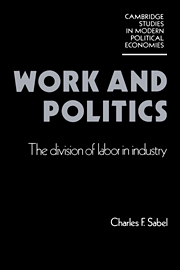3 - Careers at work
Published online by Cambridge University Press: 13 October 2009
Summary
Suppose for the moment that capitalists compartmentalize labor markets as described in the previous chapter. Why do workers put up with the possibilities for work, often appallingly limited from a middle-class point of view, that capital offers?
To many the question will seem as ridiculous as asking why men put up with injustice and oppression. An obvious answer is that they have to: Rebels are crushed by those who want the world as it is; those who refuse bad jobs find none better. But even if it were proved that fear suffocates revolutionary thoughts, brute necessity is not an exhaustive explanation of why workers accept certain jobs.
There is much evidence, we will see, that workers choosing jobs often pick one that most of us would find unappealing. Immigrants, for example, frequently prefer relatively high-paying, unskilled, insecure, dead-end jobs to jobs that pay less but offer the chance to learn skills–jobs, in other words, with a future. There are also cases of unskilled workers who more or less accidentally reveal an extraordinary aptitude for some line of work, and then refuse promotion. Nor is it uncommon for very skilled craftsmen to refuse to compete for promotions for which they are and know themselves to be superbly qualified. And there are, to take a final and more pointed example, many instances of workers bearing the economic and psychological hardships of unemployment rather than accepting just the kinds of jobs that immigrants seem most willing to take.
- Type
- Chapter
- Information
- Work and PoliticsThe Division of Labour in Industry, pp. 78 - 126Publisher: Cambridge University PressPrint publication year: 1982



